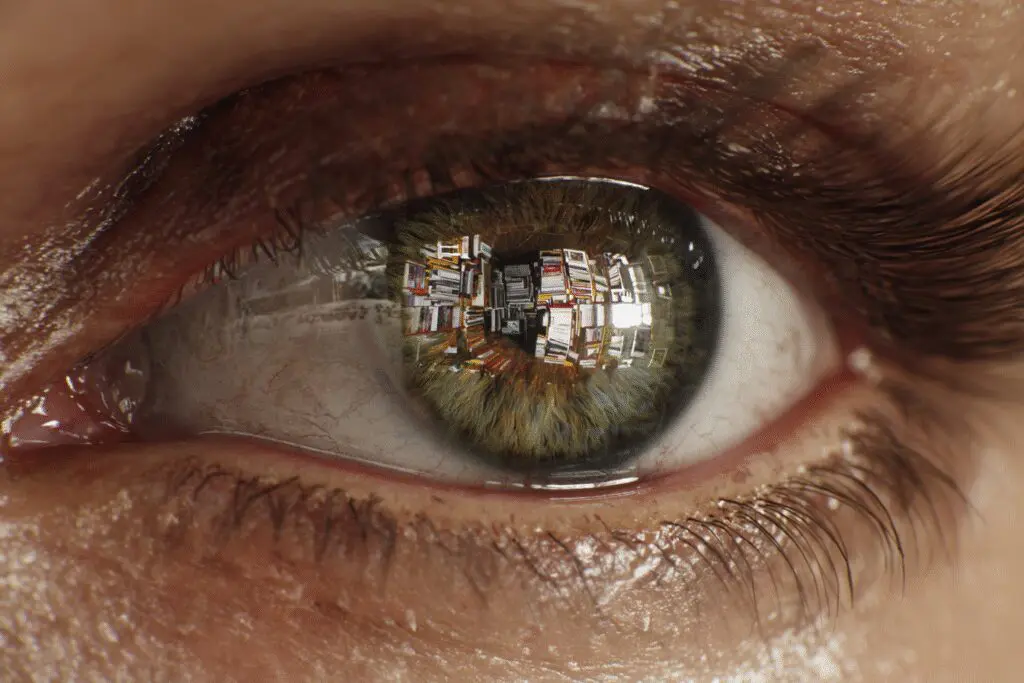Let’s cut right to the chase, because you’re here for an answer. The belief that the human eye can only see around 24, 30, or even 60 frames per second (FPS) is one of the most persistent myths on the internet. The truth is, there’s no single, fixed number. Your eye isn’t a digital camera with a rigid specification sheet. Instead, it’s an incredibly complex biological sensor that sends a continuous stream of information to your brain. Therefore, asking how many FPS can the eye see is a bit like asking how many colors a painter can use; the answer is, “it depends.”
Our visual system doesn’t see in “frames.” It perceives a constant flow of light and information. What we can measure, however, is the point at which we stop seeing individual flickering images and instead perceive them as a smooth, continuous motion. This concept is the key to understanding why a higher frame rate on your gaming monitor feels so much better, even if you can’t consciously count every single frame.
For years, I was perfectly happy with my 60Hz monitor. I genuinely believed that anything more was just marketing fluff, a placebo effect for competitive gamers. It wasn’t until I sat down at a friend’s house and played a familiar game on his 144Hz setup that the difference hit me like a ton of bricks. The smoothness was undeniable. When I went home to my own PC, it felt sluggish and choppy, something I had never noticed before. That personal experience sent me down a rabbit hole to understand the real science behind it all.
More in FPS & Competitive Gaming Category
What Is the Difference Between Seeing Frames and Perceiving Motion?
This is the most crucial distinction to make. We don’t see the world in a series of still pictures. When you watch a bird fly across the sky, you aren’t processing 60 individual images of that bird every second. You are perceiving a fluid, unbroken line of movement. Your brain is the ultimate editor, seamlessly stitching together the information your eyes provide.
The number of “frames” we can distinguish depends entirely on the context. A movie at 24 FPS looks perfectly fine because it incorporates motion blur, which helps our brains smooth over the gaps between frames. Video games, however, are a different beast entirely. Each frame in a game is a perfectly crisp, computer-generated image. Without sufficient motion blur, a low frame rate becomes noticeably jerky because our brains can more easily spot the “gaps” between the still images.
So, Why Does a 144Hz Monitor Feel So Much Smoother Than 60Hz?
When you move your mouse across a 60Hz screen, the cursor’s position is updated 60 times every second. On a 144Hz screen, it’s updated 144 times. While you may not be able to consciously say, “I just saw all 144 updates,” your brain absolutely perceives the increased smoothness. The motion is simply more fluid and true-to-life.
The information is more current. In a fast-paced game, this means you are seeing what’s happening with less delay, allowing for faster reaction times and more precise aiming. The difference is less about seeing individual frames and more about the quality and fluidity of the motion presented to your eyes.
What is the Flicker Fusion Threshold and Why Does it Matter?
Now we’re getting into the real science of it. The “flicker fusion threshold” is the point at which a flickering light is perceived as a steady, continuous source of light. This is the closest scientific concept we have to answering the FPS question. Think of an old fluorescent light bulb that you can sometimes see buzzing or flickering, especially out of the corner of your eye. That’s you perceiving the light turning on and off dozens of time per second.
A modern LED light flickers much faster, well beyond your flicker fusion threshold, so it appears as a solid, unwavering light. Your brain can’t keep up with the flickering, so it “fuses” the images together. This threshold is not one single number for everyone; it changes based on several factors.
How Does the Brain Process This Flickering Information?
Your brain is constantly trying to make sense of the world with the least amount of effort. When presented with a rapidly flashing light, its initial response is to process each flash. However, as the frequency increases, it reaches a point where it’s more efficient to just interpret the light as being constantly “on.” This saves a tremendous amount of processing power. According to researchers, this phenomenon is a fundamental aspect of our temporal visual processing. For a deeper academic dive, the UC Berkeley Helen Wills Neuroscience Institute provides excellent context on the Flicker Fusion Frequency and how our brains handle this.
The key takeaway is that for some stimuli, the human eye and brain can register flashes at incredibly high rates, sometimes well over 200 times per second in laboratory conditions.
What Factors Change How Many FPS We Can Perceive?
As we’ve established, your ability to perceive flicker or motion isn’t set in stone. It’s a dynamic process that shifts based on the situation. I’ve noticed this myself; sometimes after a long day, the difference between two refresh rates seems less obvious than when I’m fresh and focused.
Here are some of the major variables that can affect your flicker fusion threshold:
- Brightness: You can detect flicker at a much higher frequency in brighter light. This is why you’re more likely to notice the strobing effect of a car’s taillights at night.
- Contrast: The higher the contrast between the “on” and “off” states of a flickering object, the easier it is to perceive. A bright light flashing in a pitch-black room is much easier to detect than a gray light flashing against a slightly darker gray background.
- Location in Your Field of View: Your peripheral vision is much better at detecting motion and flicker than your central vision. This is an evolutionary trait; it helped our ancestors spot a predator sneaking up from the side. It’s also why you might notice the flicker of a monitor out of the corner of your eye, but it looks stable when you look directly at it.
- Your Own Biology: Factors like age, fatigue, and even what you’ve just been looking at can alter your perception from moment to moment.
Is There a Difference Between a Trained and Untrained Eye?
Absolutely. A person who spends eight hours a day playing competitive shooters on a high-refresh-rate monitor will become far more attuned to the subtleties of motion fluidity than someone who primarily uses a computer for browsing the web. Their brain has been trained to look for and react to the slightest inconsistencies in motion.
This isn’t just about video games. Think about a professional baseball player trying to hit a 100 mph fastball. They have trained their visual system to track that tiny object moving at incredible speeds, a feat that would be impossible for the average person. Their brains are conditioned to process that high-speed visual information more efficiently.
Are Fighter Pilots Different? Unpacking the Urban Legends
You’ve probably heard the myth: fighter pilots can see hundreds of frames per second, allowing them to identify an enemy plane from a single, flashed image. This is a classic example of a misunderstanding of how vision works.
While it is true that pilots are rigorously trained to have exceptional visual acuity and rapid object identification skills, they don’t see in more “frames” than anyone else. What they can do is extract a massive amount of information from a very brief visual event. In tests, pilots could indeed identify the type of aircraft from an image flashed for as little as 1/220th of a second.
This isn’t because they “saw the frame.” It’s because their brains are so highly trained that they can process that momentary snapshot of information and fill in the blanks with incredible accuracy. It’s a testament to the brain’s processing power, not a superpower of the eyeball itself.
My Own Journey From 60Hz Skeptic to High-Refresh-Rate Believer
I want to circle back to my personal experience because I think it reflects the journey of many people. For years, the “60 FPS is enough” argument made logical sense to me. Movies were 24 FPS, TV was 30 or 60. Why would I need more? I dismissed the high-refresh-rate craze as a marketing gimmick.
My setup at the time was a decent gaming PC with a standard 60Hz IPS monitor. It looked great, and I was happy with it. Then came the fateful day I tried my friend’s 144Hz monitor. The game wasn’t new, it was one I had played for hundreds of hours. But on his screen, it felt completely different.
Here’s a breakdown of what I noticed:
- Mouse Movement: The cursor on the desktop was the first giveaway. It glided across the screen with a buttery smoothness I had never experienced.
- In-Game Aiming: In the first-person shooter we were playing, tracking moving targets felt intuitive and directly connected to my hand movements. There was a sense of immediacy that was missing on my 60Hz panel.
- Reduced Motion Blur: When quickly turning my character around, the world remained clearer and less smeared. It was easier to spot enemies while in rapid motion.
When I returned to my 60Hz monitor, the experience was jarring. The smooth motion I had just taken for granted was gone, replaced by what now felt like a series of distinct steps. My brain, having just adapted to a higher quality of motion, was now keenly aware of the limitations of the 60Hz display. I ordered a 144Hz monitor the very next day.
What’s the Point of Diminishing Returns for FPS?
Okay, so we’ve established that higher is generally better. But is there a limit? Yes, absolutely. The concept of diminishing returns is very real when it comes to frame rates. The difference between 30 FPS and 60 FPS is monumental. The jump from 60 FPS to 120 or 144 FPS is still very noticeable and, for many, a game-changer.
However, the leap from 144 FPS to 240 FPS is far more subtle. For some, especially highly competitive esports athletes, that small extra degree of smoothness and reduced latency can provide a competitive edge. For the average person, though, the difference might be barely perceptible, if at all.
Do You Personally Need More Than 144Hz?
This is a personal decision that depends on your use case and sensitivity. I’ve tried 240Hz monitors, and while I can tell there’s a slight improvement if I really look for it, it doesn’t provide the same revolutionary feeling as the jump from 60Hz to 144Hz did.
My advice for most people is this:
- If you’re on a 60Hz monitor, upgrading to 120Hz or 144Hz will be a massive, worthwhile improvement for gaming and even general desktop use.
- If you already have a 144Hz monitor, an upgrade to 240Hz or even 360Hz is a luxury, not a necessity. It’s for those who want every possible competitive advantage, no matter how small.
So, What’s the Final Verdict on Human Vision?
The human visual system is not a simple input device. It’s a dynamic, adaptive, and incredibly powerful system where the brain does most of the heavy lifting. There is no single FPS number that the eye can see. Instead, our perception of motion and flicker is a fluid spectrum that depends on brightness, contrast, and where an object is in our field of view.
We can definitely perceive the differences in smoothness offered by frame rates well above 60 FPS, with many people easily seeing the benefits of 120 FPS, 144 FPS, and even higher. The question is not about seeing individual frames. It’s about feeding your brain a stream of information so smooth and dense that it can create a convincing and responsive illusion of motion. The better the information, the better the illusion.
Frequently Asked Questions

Is there a limit to how many FPS the human eye can see, and what is the future of display technology?
While current technology reaches very high refresh rates like 500Hz, the perceptible benefit for most users diminishes beyond around 120 to 240 FPS. The future focuses not just on higher FPS but also on improvements in response time, resolution, and visual quality to enhance the overall viewing experience.
What factors influence how many FPS a person can perceive?
Perception of FPS varies based on individual factors such as age, training, and the specific activity. Younger people, professional gamers, and athletes tend to notice higher FPS more easily. External factors like screen brightness, content type, and peripheral vision also play a role.
Why do movies often use 24 FPS, and does this limit our perception?
Movies use 24 FPS mainly due to historical and cost reasons, with motion blur helping convey smooth motion. This does not mean that human perception is limited to 24 FPS; higher frame rates can provide even smoother motion, especially in fast-action scenes or gaming.
Can the human eye see differences in high frame rates like 120 or 240 FPS?
Yes, humans can perceive differences in high frame rates under certain conditions, such as smoother motion in fast-paced videos or more responsive gameplay. People often notice subtle improvements when moving from 60 to 120 or 240 FPS, especially in activities requiring quick reactions.
What is FPS and how does it relate to human vision?
FPS, or Frames Per Second, refers to how many still images a screen displays each second to create the illusion of motion. However, the human eye does not have a frame rate like a camera; instead, it sends a continuous flow of light signals to the brain, which processes them to perceive motion.





